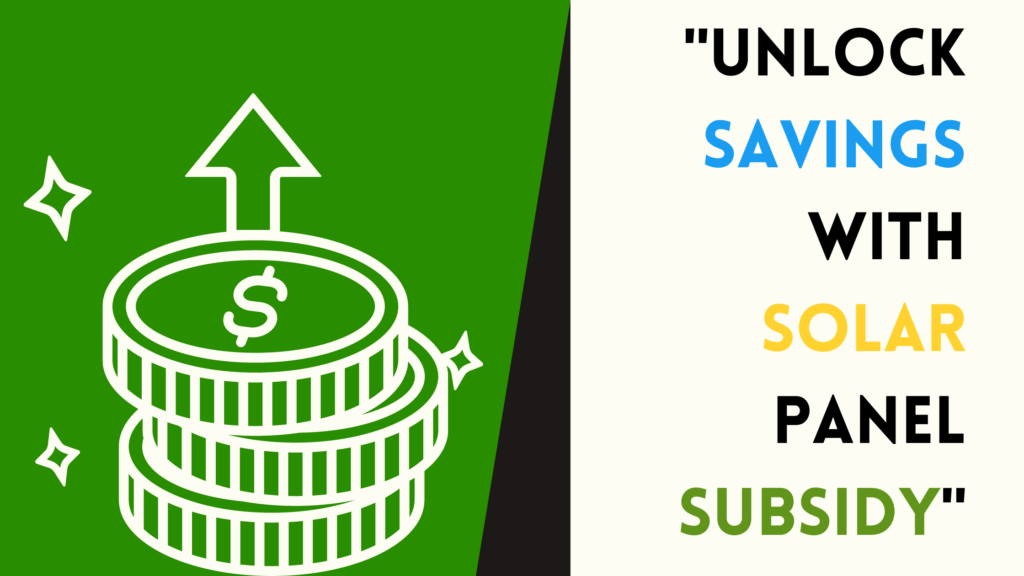"Maximize Your Savings with Solar Panel Subsidy Programs"
Introduction
In today’s era of rising energy costs and growing environmental concerns, the shift towards renewable energy sources like solar power has become imperative. Solar panels offer a sustainable and cost-effective solution to meet our energy needs while reducing our carbon footprint. However, the initial investment required for solar panel installation can be a deterrent for many homeowners and businesses. This is where solar panel subsidy programs come into play, providing financial incentives to make solar energy more accessible and affordable. In this blog, we will delve into the benefits of solar panel subsidy programs, how they work, and how you can maximize your savings by taking advantage of these incentives.
Understanding Solar Panel Subsidy Programs
Solar panel subsidy programs are initiatives offered by governments, utilities, and other organizations to encourage the adoption of solar energy. These programs aim to offset the upfront costs associated with installing solar panels, making them more affordable for consumers. Subsidies can take various forms, including tax credits, rebates, grants, and low-interest loans. By leveraging these incentives, homeowners and businesses can significantly reduce their investment in solar energy systems.
Benefits of Solar Panel Subsidy Programs
1. Reduced Upfront Costs: The primary benefit of solar panel subsidy programs is the reduction of upfront costs. By providing financial incentives, these programs make solar energy more accessible to a broader range of consumers, regardless of their financial capabilities.
2. Accelerated Return on Investment: With the assistance of subsidies, the payback period for solar panel installations is shortened. This means that homeowners and businesses can start reaping the financial benefits of solar energy sooner, including reduced electricity bills and potential revenue from excess energy production.
3. Increased Affordability: Solar panel subsidy programs make solar energy more affordable for a wide range of consumers, including low-income households and small businesses. This accessibility helps democratize access to renewable energy and promotes energy independence.
4. Stimulated Economic Growth: By incentivizing the adoption of solar energy, subsidy programs stimulate economic growth in the renewable energy sector. This includes job creation, investment in solar infrastructure, and technological advancements in solar panel technology.
How Solar Panel Subsidy Programs Work
1. Tax Credits: One of the most common forms of solar panel subsidies is the federal Investment Tax Credit (ITC) in the United States. This credit allows homeowners and businesses to deduct a percentage of their solar installation costs from their federal taxes, reducing their tax liability.
2. Rebates: State and local governments often offer rebates to homeowners and businesses that install solar panels. These rebates provide a direct financial incentive, either as a cash payment or a reduction in the total installation cost.
3. Grants: Some subsidy programs offer grants to support the adoption of solar energy. These grants may be targeted towards specific groups, such as low-income households or community solar projects, to ensure equitable access to solar energy benefits.
4. Low-Interest Loans: In addition to grants and tax credits, some subsidy programs offer low-interest loans to help finance solar panel installations. These loans provide homeowners and businesses with affordable financing options and enable them to spread the cost of installation over time.
Maximizing Your Savings with Solar Panel Subsidy Programs
1. Research Available Programs: Start by researching the solar panel subsidy programs available in your area. This may include federal, state, and local incentives, as well as utility-specific programs. Understanding the eligibility criteria and application process is crucial.
2. Consult with Solar Installers: Professional solar installers can provide valuable guidance on navigating subsidy programs and maximizing your savings. They can help you assess your eligibility, choose the right incentives, and ensure compliance with program requirements.
3. Optimize Your Solar System Design: Work with your solar installer to design an efficient solar energy system that maximizes energy production and savings. Factors such as panel placement, orientation, and shading should be carefully considered to optimize performance.
4. Take Advantage of Multiple Incentives: Many subsidy programs can be combined to maximize your savings. For example, you may qualify for both federal tax credits and state rebates, allowing you to stack incentives and reduce your overall investment in solar energy.
Conclusion
Solar panel subsidy programs play a crucial role in promoting the adoption of solar energy and accelerating the transition to a clean and sustainable energy future. By providing financial incentives to offset the upfront costs of solar panel installations, these programs make solar energy more accessible and affordable for homeowners and businesses alike. To maximize your savings with solar panel subsidy programs, it’s essential to research available incentives, consult with professional installers, and optimize your solar system design. By taking advantage of these incentives, you can unlock significant savings while contributing to a greener and more sustainable world powered by solar energy.


